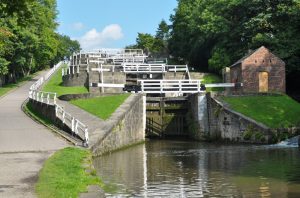It was our last Ripon lecture of the season and Eric Jackson, from the Canal and Rivers Trust, gave us a fascinating insight into the long history of our country’s canals. Canals are not new. The Romans had them – including Foss Dyke, still in use. However, it was the Industrial Revolution which led to the need for much heavy or fragile equipment to be transported by canal. He told us about Francis Egerton, the 18th century 3rd Duke of Bridgewater. Egerton was the founder of British inland navigation, and he built the Bridgewater Canal, connecting the coal mines from his estates in Worsley to the city of Manchester. At that time, it cost just 2/6d. to transport one ton of coal from Worsley to Manchester. This canal revolutionized transportation and trade, serving as a model for subsequent canal development in Britain, and its success inspired other entrepreneurs, spurring Canal Mania — a canal building boom in Britain during the late 18th century.

Canals enabled Britain to become the world’s first “industrial power”, and there were 4,800 miles of them by 1850. Eric showed us some beautiful pictures of our Yorkshire canals, including the 5 Rise Locks at Bingley, and also an example of one very attractive lock keeper’s cottage with its barrel roof. He told us that 1780 to 1830 was the Golden Age of Canals but the coming of the railways meant some were sold, some bought out by the railways, and some just abandoned.
Coming more up to date, the 1950s and 1960s saw canals decline further as some 800 miles were abandoned but, in the 1970s, 500 miles were restored. Robert Aickman (1914 – 1981) was an English writer and conservationist. Aickman is remembered for his co-founding of the Inland Waterways Association, a group devoted to restoring and preserving England’s then neglected and largely derelict inland canal system. Now there are some 35,000 boats on the waterways — carrying holiday makers, not coal!
